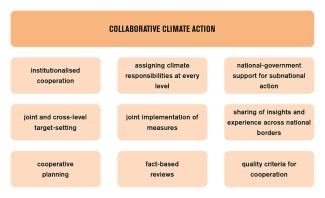Collaborative Climate Action
Aspiration enhancing cooperation

CCA is close cooperation across different levels of government. The idea is to define climate goals together and implement policies jointly. CCA is a precondition for ambitious climate action because there is no other way to grasp every opportunity that may arise.
CCA may seem obvious and even indispensable but it is far from standard practice. That is true in industrialised countries, emerging markets and developing countries. Across the world, there are only a few examples of all levels of government being assigned, by law and in practice, a role in reducing greenhouse-gas emissions and adapting to climate change.
The political relevance of national governments is well understood. In order for action to be most effective, we need greater appreciation of subnational authorities, including municipal and regional governments. CCA takes account of that need.
A recent GIZ publication (2021) has spelled out why cooperation across all levels of government matters – and how to achieve such cooperation. The report includes documents from around the world (see box), indicating how greater cooperation between national governments, regions and municipalities can be accomplished.
The GIZ report summarises why CCA is so important:
- If all levels of government coordinate their capacities, expertise, jurisdictional tasks, budgets, networks et cetera they will achieve more together than each could on its own.
- By avoiding parallel efforts and supporting one another, their staff, time, funding et cetera will be employed more efficiently.
- CCA contributes directly to making climate policy more coherent, from the international to the local level.
- Collaboration is particularly important for efforts to reduce greenhouse-gas emissions in urban areas. Such efforts are especially urgent and especially promising.
- The subsidiarity principle states that regulatory authority should always be situated “at the lowest level possible, but highest necessary level”. It is a sensible principle for governance in general and makes perfect sense in regard to climate issues.
According to the global initiative Coalition for Urban Transitions national and regional governments are fully in charge of about 35 % of the urban potential for abatement, while municipal governments are responsible for about 28 %. However, 37 % of the potential can only be tapped in joint action. These data from the Coalition’s 2019 report “Climate Emergency – Urban Opportunity” reinforces the relevance of CCA.
The GIZ publication identifies and categorises measures that need to be taken. Among other things, they include (see illustration graph):
- institutionalised cooperation,
- joint and cross-level target-setting,
- cooperative planning,
- assigning climate responsibilities at every level,
- joint implementation of measures,
- fact-based reviews,
- national-government support for subnational action,
- the sharing of insights and experience across national borders and
- defining criteria for successful collaboration.
Of course, horizontal cooperation – between ministries, sectors or thematic areas – is an equally important precondition for successful climate action. Moreover, civil society, the private sector, academia and the media must be involved too.
International CCA initiatives
International climate collaboration offers many opportunities for enacting climate policies across government levels. The Paris Agreement on Climate Change requires all signatory states to submit so-called Nationally Determined Contributions (NDCs), and input from all levels of government is needed to draft them. They spell out targets and duties. In the best case, an NDC will include a monitoring and reporting system, so all relevant governments agencies could submit data. Moreover, an NDC should include mechanisms for the close cooperation of agencies at different levels.
Apart from NDCs, nations are obligated to draft long-term strategies (LTS) for climate protection. The goal is to show how they will make their economies greenhouse gas-neutral by mid-century. In this context, opportunities arise for national governments, regions and municipalities to draft strategies of their own and, on that foundation, move on to collaborative policymaking.
Regional governments and authorities have much to contribute to an LTS. They can establish regulations within their jurisdictions, involve stakeholders, provide incentives and network among their municipalities. They can establish regional energy and climate-protection agencies, support model projects and ensure that information is passed on systematically. Local governments can spell out how they will use their authority over land use, building, infrastructure, transport systems et cetera to enable low- and zero-carbon development.
Since in 1995, the first annual Summit of the UNFCCC (UN Framework Convention on Climate Change) took place in Berlin, local governments were involved in these summits. More recently, regional governments have been accompanying the proceedings as well. They all share their climate-protection goals, strategies and activities. Organised through the “Local Governments and Municipal Authorities (LGMA) Constituency”, they have suggested the motto “Multilevel action COP26” for the upcoming UNFCCC conference (26th Conference of the Parties – COP26) in Glasgow in November 2021. Scotland is supporting this approach.
More and more international projects, declarations and committees are based on the conviction that only true collaboration between government levels will bring about a fast and far-reaching transformation to carbon neutrality. At the end of 2020, this idea was also laid out in the New Leipzig Charter, which is intended to guide urban development in Europe.
Links
Coalition for Urban Transitions, 2019: Climate emergency, urban opportunity.
https://urbantransitions.global/wp-content/uploads/2019/09/Climate-Emergency-Urban-Opportunity-Priorities-for-National-Governments-FINAL.pdf
GIZ, 2021: Collaborative Climate Action – a prerequisite for more ambitious climate policy. Berlin, Deutsche Gesellschaft für Internationale Zusammenarbeit (GIZ).
https://collaborative-climate-action.org/cca-report/
New Leipzig Charter:
https://www.bmi.bund.de/SharedDocs/faqs/EN/topics/building-housing/leipzig-charta-en/leipzig-charter.html
Monika Zimmermann works as an independent consultant for GIZ.
monika.b.zimmermann@online.de










